A Guide to Growth-Focused B2B Events
October 4, 2025
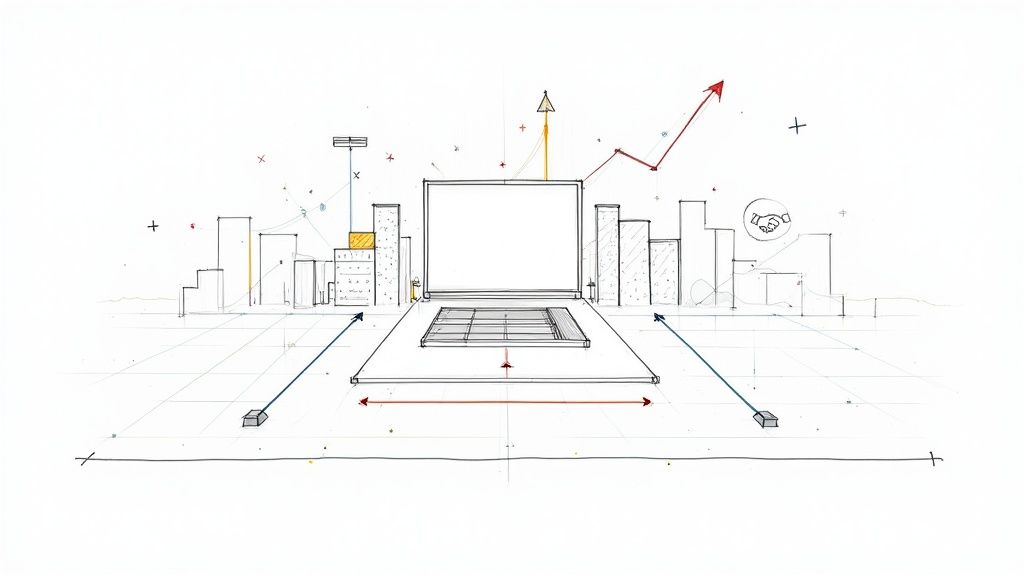
In a world filled with digital noise, B2B events are a potent way to forge real connections and spark business growth. Think of them as powerful engines that build communities, cement your brand's authority, and compress months of sales pipeline progress into just a few days. They accomplish things that purely digital strategies cannot.
The True Power of Modern B2B Events
Imagine your business isn't just a company, but a thriving city. In this city, B2B events are the central square—the buzzing hub where commerce ignites, new ideas are born, and game-changing relationships are built. They’re much more than just gatherings; they are strategic, high-impact moments in the customer journey that build trust and create momentum.
Purely digital outreach, while essential, can feel impersonal. Emails get deleted, and ads get scrolled past. A well-run B2B event, on the other hand, creates a shared experience. It puts your team face-to-face (or screen-to-screen) with prospects, sparking candid conversations and turning abstract brand promises into something tangible.
In a market where trust is the ultimate currency, B2B events provide the perfect environment to earn it. They offer a rare opportunity for unfiltered dialogue, allowing potential customers to meet the people behind the product and see your company's values in action.
Why Events Are a Critical Growth Channel
The importance of events in a modern B2B marketing mix is significant. They're a multi-tool, hitting several big objectives at once, which makes them an incredibly efficient and high-impact investment. When planned with clear goals in mind, B2B events can:
- Build an Authentic Community: Events bring together customers, partners, and prospects who all share common goals and challenges. This fosters a powerful sense of belonging around your brand.
- Establish Brand Authority: Hosting an event with excellent content and respected speakers instantly positions your company as a thought leader and a central player in your industry.
- Accelerate the Sales Pipeline: Direct interaction with decision-makers is invaluable. It lets your sales team qualify leads, handle objections on the spot, and dramatically shorten the sales cycle.
This isn't just a hunch; market trends back it up. The global event industry is set to expand from $736.8 billion in 2021 to an incredible $2.5 trillion by 2035. On top of that, 66% of organizers are planning to schedule more events in 2025, which shows a massive and growing confidence in this channel.
Aligning Objectives with Outcomes
The key to unlocking this power is strategic alignment. Before you think about booking a venue or designing an email invitation, you must define what success looks like.
Are you trying to generate a flood of new leads for your SDR team? Or is the goal to deepen relationships with your top enterprise clients? Perhaps you’re looking to launch a new product with the biggest splash possible.
Each of these goals demands a different approach, a unique event format, and a specific set of metrics to track success. Getting this right is fundamental, as events are just one of many powerful B2B marketing channels you can use to hit your targets. By setting clear objectives from the very beginning, you transform a simple gathering into a calculated business move that delivers measurable results.
Choosing the Right Event Format

Picking the right event format—in-person, virtual, or hybrid—is the first big decision you'll make, and it shapes everything that follows. This isn't just about weighing a simple list of pros and cons. It’s about matching the medium to your mission.
Think of it as choosing the right stage for your brand’s story. Each format offers a completely different way to connect with your audience and hit your business goals.
The decision really comes down to what you want to accomplish. Are you trying to forge deep, trust-based relationships with a handful of key accounts? Or is your goal to broadcast a major announcement to the largest possible audience across the globe? Your answer will point you in the right direction.
In-Person Events: The Gold Standard for Connection
You cannot deny the energy in a room full of people sharing an experience. In-person B2B events are still the undisputed champion for building meaningful relationships and a genuine sense of community. In fact, a massive 78% of organizers say in-person events are their most impactful marketing channel.
These events create an immersive environment that engages all the senses. Handshakes, spontaneous chats over coffee, and live product demos build a level of connection that digital formats cannot quite replicate.
- When to Choose In-Person: This is your go-to format for high-stakes goals. Think closing major deals, strengthening ties with C-suite clients, or creating an unforgettable brand experience that builds loyalty for years to come.
- Example in Action: Imagine a B2B SaaS company launching a new, premium enterprise platform. They host an exclusive, single-day summit. This intimate setting allows their top engineers and executives to personally walk key prospects through the new features, tackle complex questions head-on, and build the confidence needed for a major investment.
The proof is in the numbers: 80% of attendees agree that in-person events are the most trusted way to discover new products and solutions.
Virtual Events: Global Reach and Unmatched Scalability
While in-person events are all about depth, virtual events are masters of scale. They completely remove geographical barriers, letting you engage a global audience without the headache and expense of travel. This makes them a phenomenal tool for broad-based lead generation, brand awareness campaigns, and delivering educational content.
The trick to a great virtual event is engagement. Without a physical room to hold their attention, you have to create excellent content and interactive experiences. This is where formats like webinars really shine. When done right, they can be a powerful engine for education and lead capture. To get the full picture, check out our ultimate guide to webinar marketing for actionable strategies.
The real advantage of virtual isn't just its reach, but its data. Digital platforms give you a trove of analytics on attendee behavior—which sessions they joined, what questions they asked, what content they downloaded—arming your sales team with priceless insights for follow-up.
Hybrid Events: The Best of Both Worlds
The hybrid model aims to deliver it all: the deep connection of in-person events combined with the massive reach of virtual. It’s an ambitious approach, and when it works, it delivers incredible value by serving two distinct audiences at once. But make no mistake, it requires meticulous planning to create a seamless experience for everyone.
A successful hybrid event is not just a livestream of an in-person gathering. It demands a dedicated strategy for the virtual crowd, complete with its own content, networking opportunities, and a host to keep them engaged. It's complex, but the payoff can be huge.
Ultimately, choosing a format isn't about which one is "better." It's about which one is best suited to hit your specific business objectives for your next B2B event. If you start with your goal, you can confidently pick the format that will turn your vision into a home run.
Your B2B Event Planning Workflow
A truly memorable B2B event never just happens. It’s the result of a deliberate, structured process that takes a bold idea and turns it into a perfectly executed experience. Event planning can feel chaotic, but a solid workflow is your command center, breaking down the complexity into manageable, repeatable steps.
Think of this framework as your guide, taking you from that initial spark of an idea all the way through post-event analysis. By moving through each phase in order, you make sure no detail gets missed and your entire team stays aligned and focused on delivering something special. This kind of structured approach is the backbone of great B2B marketing, something we dive into in our guide on B2B marketing planning proven strategies for success.
Phase 1: The Strategic Foundation
Before you book a speaker or even think about a landing page, you have to define your why. This foundational stage is all about asking the big questions that will guide every single decision you make later on. Get this part right, and everything else falls into place.
Start by setting crystal-clear, measurable goals. Are you trying to generate 500 new marketing-qualified leads? Or is the main objective to book meetings with 25 key enterprise accounts? These specific targets will shape your content, your promotion, and even your venue choice.
Next, build out a realistic budget. This isn't just about a final number; it's a strategic document that funnels resources to your biggest priorities. A well-planned budget prevents those last-minute scrambles and ensures you can invest where it counts, whether that's a high-profile keynote speaker or an unforgettable attendee experience.
This infographic breaks down the first few steps when you're looking for a physical venue.
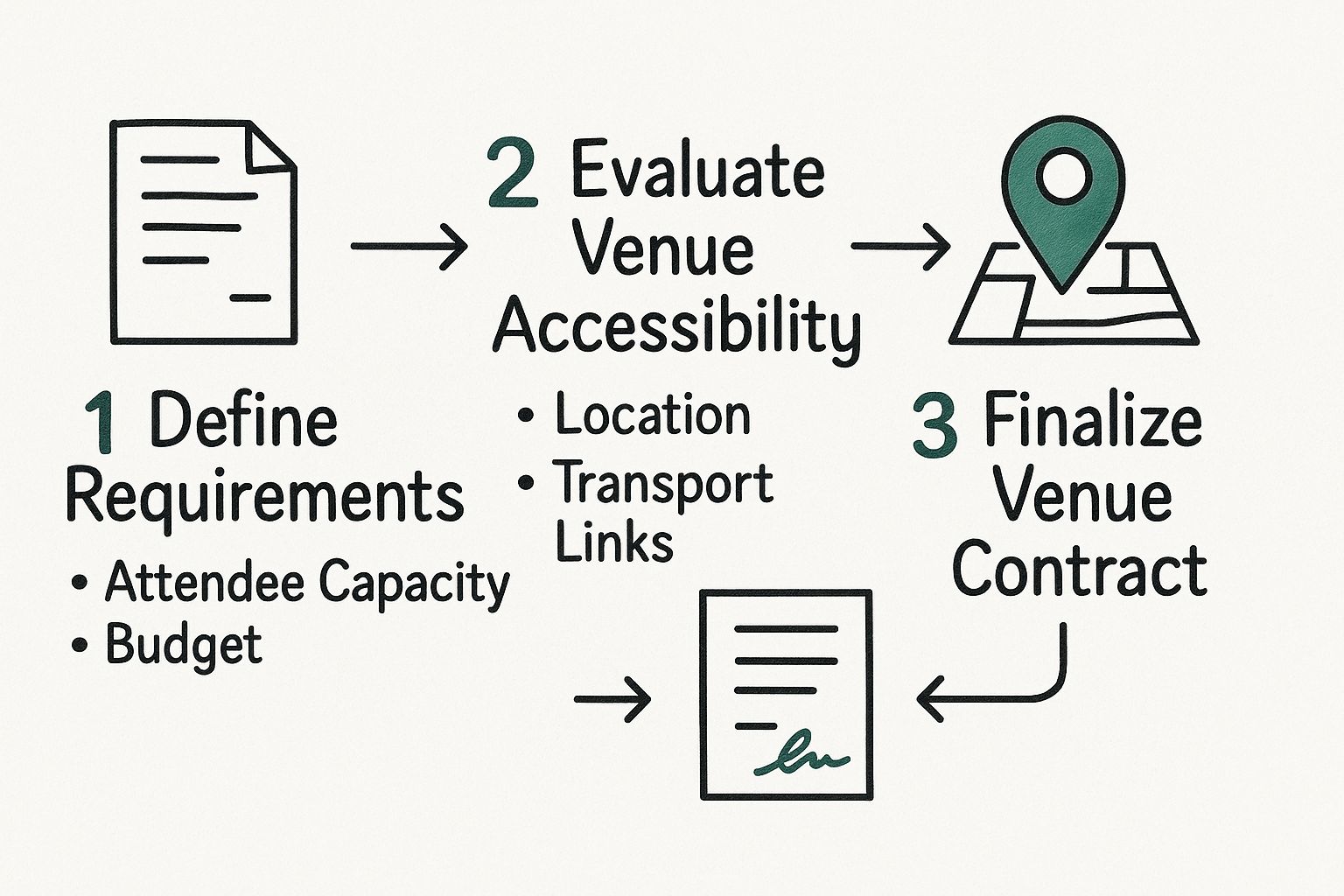
As you can see, core requirements like your budget and expected capacity directly shape how you evaluate venues, ultimately leading you to the final decision.
Phase 2: Content and Promotion
With your strategy locked in, it’s time to build the heart of your event and start generating some buzz. This is where you craft the experience that will pull in your target audience and keep them engaged.
The key pieces of this phase include:
- Securing Speakers: Find and book industry experts and thought leaders who will not only draw a crowd but deliver incredible value.
- Developing a Promotion Plan: Build a marketing campaign that hits multiple channels—email, social media, and content marketing—to drive registrations.
- Crafting the Agenda: Design a schedule packed with compelling sessions, valuable workshops, and dedicated time for networking.
A great agenda tells a story. It should guide attendees on a journey, starting with big-picture inspiration and moving toward practical, actionable takeaways that they can apply to their own work.
Phase 3: Logistics and Execution
This is where the plan becomes reality. Managing logistics is all about orchestrating countless moving parts to create a seamless experience for every single attendee, speaker, and sponsor.
Your execution checklist needs to cover everything—from A/V setup and catering to signage and staffing. Technology is a huge part of this. A smooth check-in process, for example, is critical for making a great first impression. To find the right fit for your event, it's worth exploring the best check-in apps for events that can cut down wait times.
Of course, the work isn’t done when the event ends. A solid follow-up strategy is what turns the energy and engagement from the event into real business results. This means sending thank-you notes, sharing session recordings, and handing off qualified leads to the sales team for prompt, personalized outreach. This final step is what elevates a good event into a great one with a measurable ROI.
How to Calculate Real Event ROI
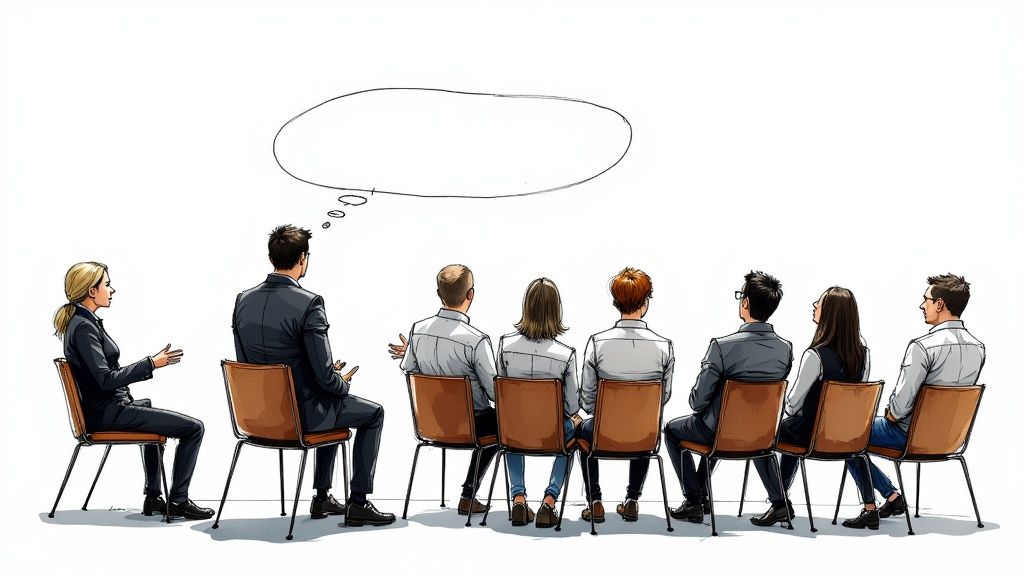
Proving the value of your B2B event isn't just about feeling good when the attendee numbers are high. Sure, metrics like social media mentions and registration counts are nice, but they don't directly impact the bottom line. The real story of your event's impact is told through the numbers that matter to the business: revenue, pipeline growth, and new customer acquisition.
Moving beyond those surface-level stats isn't optional anymore. A whopping 95% of event teams say that proving ROI is a top priority. Yet, 38.2% of them admit they still struggle to actually do it. This gap shows just how critical a solid measurement plan really is.
If you want to tell a compelling ROI story, you have to speak the C-suite's language. That means turning event activities into hard numbers that show real business momentum.
Key Formulas to Measure Event Impact
Calculating event ROI really comes down to a simple idea: compare the value you generated to what you spent. The trick is getting specific about what "value" means for your goals. Here are a couple of essential formulas to get you started.
1. Pipeline Generated from Event Leads
This is a forward-looking metric that shows how your event is setting up future sales. It’s a fantastic way to demonstrate immediate value before the deals even close.
- Formula: (Total Value of Sales Opportunities from Event Leads) / (Total Event Cost)
- Example: Let's say your annual user conference cost $100,000 to put on. From the leads you generated, your sales team qualified enough opportunities to add $750,000 to the sales pipeline. That gives you a pipeline ROI of 7.5x.
2. Customer Acquisition Cost (CAC) from Events
This formula helps you figure out how efficient your event is at bringing in new customers, which you can then compare against other marketing channels like paid search or content.
- Formula: (Total Event Cost) / (Number of New Customers Acquired from Event)
- Example: Your $100,000 event led directly to 20 new customers signing on the dotted line. Your event CAC is $5,000 per customer.
Tracking Beyond the Initial Numbers
A great event's influence doesn't stop when the lights go out. To get the full picture, you need strategies for measuring real event success that capture the value that unfolds over time.
One of the most powerful metrics here is Event-Influenced Revenue. This tracks every deal that closed where the event was a meaningful touchpoint in the buyer's journey—even if it wasn't the first or last one. It acknowledges that B2B sales cycles are long and complex, and events are often the catalyst that builds relationships and speeds up decisions.
True event ROI isn't a single number calculated the day after your event. It's a narrative that unfolds over months, revealed through pipeline growth, closed deals, and stronger customer relationships.
Another crucial long-term metric is the impact on Customer Lifetime Value (LTV). By comparing the LTV of customers you acquired at events to those from other channels, you can prove that your event-sourced customers are more loyal and ultimately more valuable over the long haul. This kind of data makes an incredibly strong case for continued investment in your event strategy. For a deeper dive, our article on how to measure marketing effectiveness offers a broader framework for tracking performance across all your initiatives.
Navigating Modern Event Management Challenges
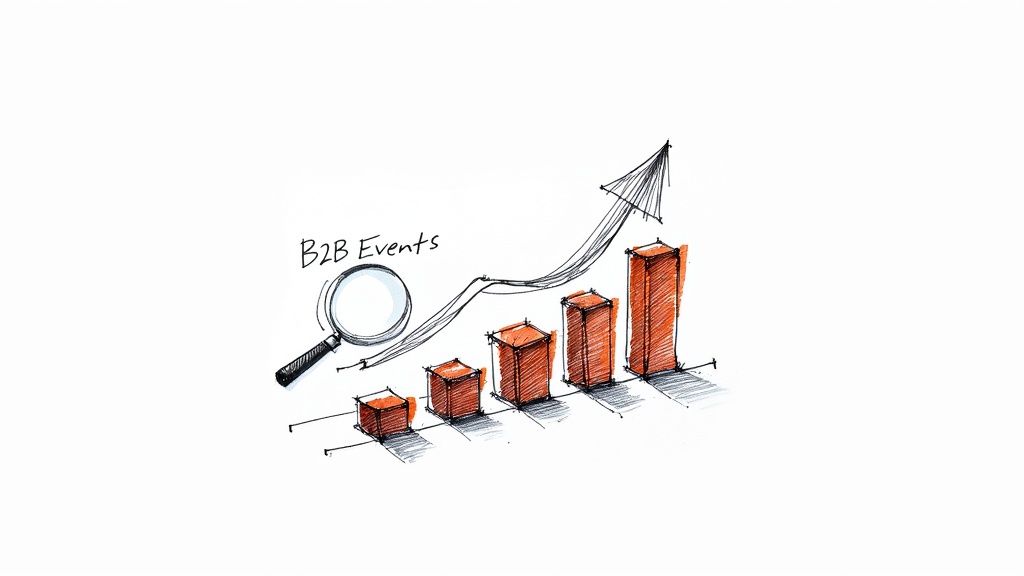
Planning an excellent B2B event today is about more than a great agenda and a few big-name speakers. Event organizers are up against a whole new set of pressures that demand a smarter, more agile approach.
We're talking about everything from tightening budgets to completely new attendee behaviors. The old playbook doesn’t cut it anymore. Success now means tackling these real-world problems head-on with practical, tested strategies.
The Budget Squeeze
One of the biggest issues is economic pressure. Inflation and soaring operational costs have put event budgets in a difficult position.
This isn't just a feeling; the numbers back it up. Nearly half (47%) of event professionals are 'very concerned' about costs outrunning their budgets. The price tags on essentials like food, drinks, and A/V services are expected to jump by as much as 50%. To cope, over half (53%) of teams are even looking to move their events to less expensive cities. You can dig into more of these event industry trends on Eventmarketer.com.
This new reality forces us to do more with less, all without sacrificing the quality of the attendee experience. It’s a balancing act, for sure.
The challenge of a tighter budget can be an incredible catalyst for innovation. It forces you to question every line item and focus relentlessly on what truly creates value for your attendees, leading to leaner, more impactful events.
Adapting to New Attendee Behaviors
Beyond the financial crunch, the way people attend events has fundamentally changed. Gone are the days when attendees would eagerly register for a conference months in advance.
Now, we're seeing a major trend toward last-minute sign-ups. This creates a ripple effect of uncertainty that can disrupt everything from venue capacity and catering orders to staffing. It makes forecasting a nightmare.
But this unpredictability isn't just a problem—it's a signal. It tells us we need more flexible event models and marketing that builds urgency closer to the event date. It’s an opportunity to adapt and get smarter.
A Playbook for Today's Problems
Running a successful event in this climate means anticipating the hurdles before they trip you up. Below are some of the most common issues we're all facing, along with practical ways to solve them.
Common B2B Event Challenges and Strategic Solutions
Overcoming these obstacles isn't about finding a single magic bullet. It’s about adopting a mindset of continuous improvement and being willing to experiment. Instead of one massive annual conference, maybe you shift to a series of smaller, more targeted micro-summits or regional roadshows. These are often more cost-effective and allow for deeper engagement.
Take a hard look at your tech stack, too. Make sure every tool you use—from registration platforms to mobile apps—is pulling its weight and making your life easier. By embracing these adaptive strategies, you can turn today's challenges into the foundation for more resilient and successful B2B events.
Frequently Asked Questions About B2B Events
Even with the best-laid plans, questions are a natural part of orchestrating an excellent B2B event. This section tackles some of the most common hurdles and questions B2B marketers run into. Think of it as your quick-reference guide for troubleshooting challenges and moving forward with confidence.
How Can We Use Technology to Improve Our B2B Events?
Technology has become the central nervous system for modern events, but the goal isn't to use tech for tech's sake. The key is to be strategic—start with your objectives, then find the tools that actually help you hit them.
For any virtual or hybrid event, a rock-solid event platform is the price of admission. It’s your digital venue, the place where all the streaming, networking, and content delivery happens. But for in-person events, technology plays a different role, elevating the experience in a few crucial ways:
- Mobile Event Apps: These are standard now. An app is your direct line to attendees for schedules, venue maps, and last-minute push notifications. A good one keeps everyone in the loop and engaged.
- AI-Powered Matchmaking: Don't leave networking to chance. Smart tools can analyze attendee profiles to suggest high-value connections with peers or sponsors, turning awkward coffee breaks into genuinely productive conversations.
- Engagement Tools: Nobody wants to just sit and listen for hours. Tools for live polling, interactive Q&A sessions, and a bit of gamification can completely change the energy in a room, turning passive attendees into active participants.
Once the event wraps up, your CRM and marketing automation platforms take center stage. This is where you connect the dots—tracking leads, analyzing attendee behavior, and ultimately measuring the long-term business impact of all your hard work.
What Are the Best Ways to Promote a B2B Event?
Getting the word out requires a multi-channel approach that builds momentum over time, not just a single email blast a week before the event.
Your first and best asset is your own database. Start by emailing your existing contacts, but get personal with it. Segment your lists by industry, role, or past behavior to craft messages that speak directly to what they care about.
Next, broaden your reach. LinkedIn is a powerhouse for B2B; use a smart mix of organic posts from company and employee profiles alongside hyper-targeted ads. You can also get a huge lift by tapping into the networks of your speakers, sponsors, and friendly industry influencers. For a deeper dive, you can explore a complete guide to B2B event marketing to build out a more robust promotional engine.
Your event's theme is a content goldmine. Create blog posts, short videos, or even a podcast series related to your topics to attract organic interest and demonstrate the value attendees will receive.
And don't forget the classics. An early-bird discount is a proven winner. It creates a little urgency and rewards people for committing early, helping you build a solid registration base right out of the gate.
How Far in Advance Should We Plan a B2B Conference?
The right planning timeline really comes down to the scale of your event. The simple rule is that more lead time is always better. It gives you more options, better negotiating power, and a whole lot less stress.
For a large-scale B2B conference with 500 or more attendees, you need to start the process 10-12 months in advance. This isn't just a suggestion; it's practically a requirement for securing a great venue and booking high-demand keynote speakers. The best spots and top-tier speakers are often locked in more than a year out. This longer runway also gives you plenty of time to build a solid budget and line up valuable sponsorships without scrambling.
- Mid-Sized Summit (100-300 attendees): A planning window of 6-8 months is a much more comfortable fit. This gives you enough time to nail down your content, run a proper promotional campaign, and handle logistics without everything feeling rushed.
- Virtual Event (Webinar or Summit): You can often pull these off with a shorter lead time, maybe 3-4 months, since you don't have to worry about venues or travel. That said, a longer promotional cycle almost always translates to more sign-ups.
No matter what kind of event you're running, giving yourself more time to plan will directly translate into a more polished and successful outcome.
What Key Metrics Belong in a Post-Event Report?
Your post-event report is where you prove your event was worth the investment. It needs to tell a clear, data-driven story that goes way beyond how many people showed up. The real goal is to connect the dots between your event activities and real business results.
A strong report blends both quantitative and qualitative data to paint the full picture.
Essential Quantitative Metrics:
- Total Registrations vs. Actual Attendance: This gives you your attendance rate, a great gut check on how compelling your final pre-event push was.
- Cost Per Attendee: Simply divide your total event cost by the number of attendees. It’s a crucial metric for gauging efficiency and planning future budgets.
- Leads Generated: Track every new lead captured, but pay special attention to how many of them become Marketing Qualified Leads (MQLs).
- Pipeline Influence: This is a big one. It's the total dollar value of every sales opportunity that included an event attendee. This is a powerful way to show how your event impacts future revenue.
- Direct Revenue Attributed: This is the ultimate metric—tracking revenue from closed-won deals that can be sourced directly back to your event.
On top of those core business metrics, be sure to include engagement data. Things like session attendance ratings, networking activity, and (for virtual events) average content viewing time add important color to your story.
Finally, bring it all home with qualitative feedback. Post-event surveys are your best friend here. Use them to measure attendee satisfaction—Net Promoter Score (NPS) is perfect for this—and to collect powerful testimonials and suggestions you can use to make your next event even better. This mix of hard numbers and human feedback is the proof you need to show your event's true value.
Ready to make your next product launch a massive success? At Big Moves Marketing, I specialize in crafting the positioning, sales tools, and launch strategies that help B2B SaaS and AI startups drive adoption and win deals. Let's connect and build a plan to hit your goals. Get in touch today!
%20-%20Alternate.svg)
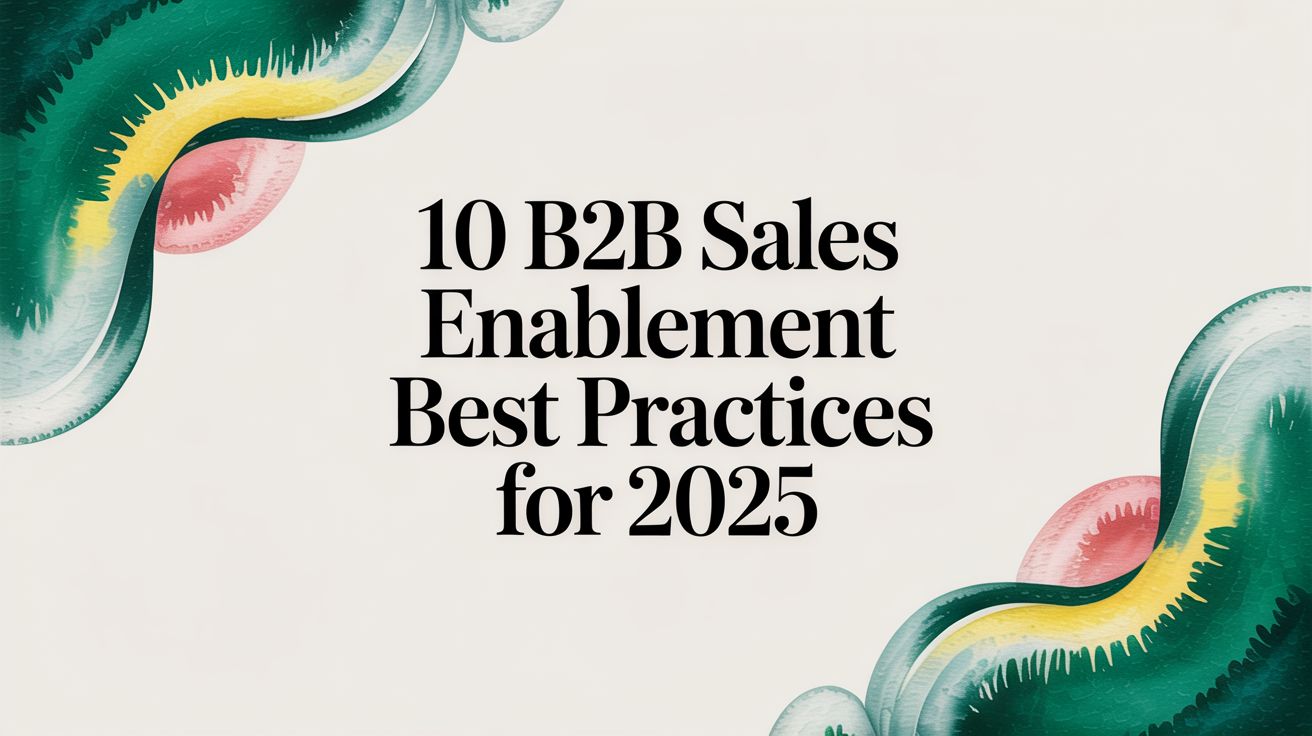
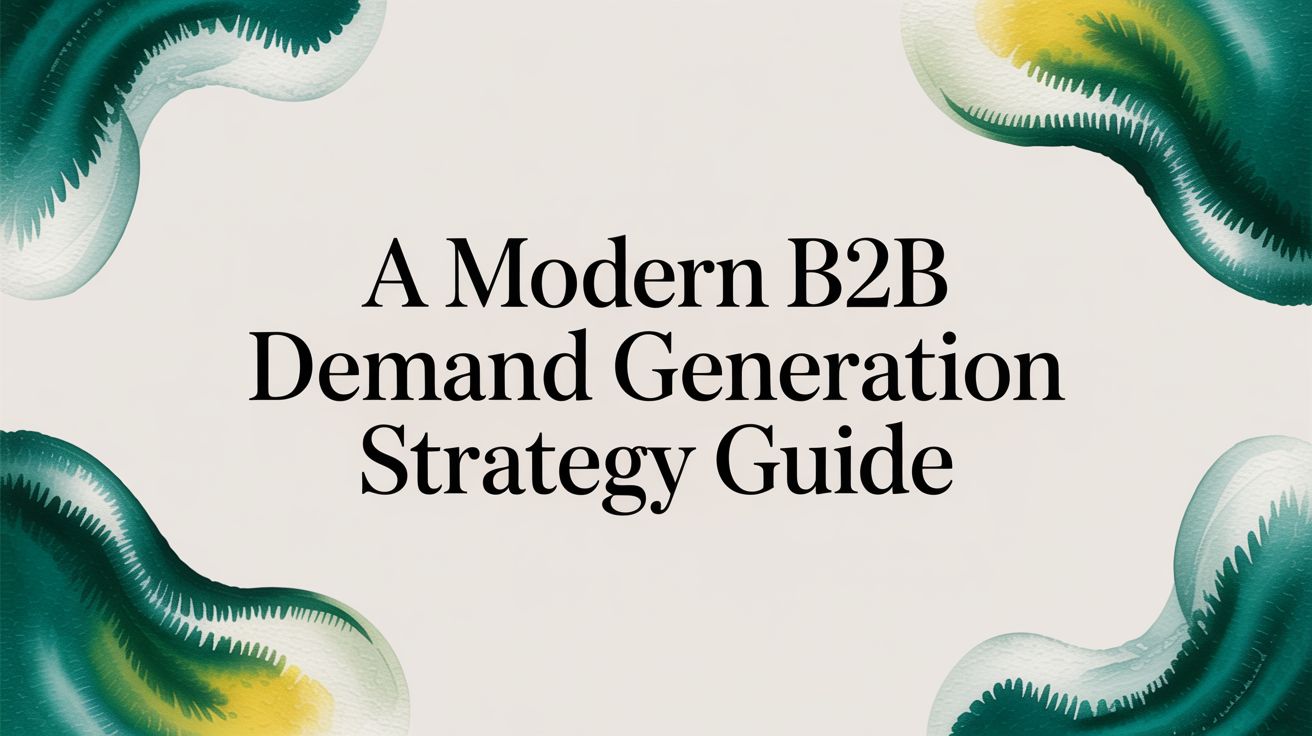
%20-%20white.svg)